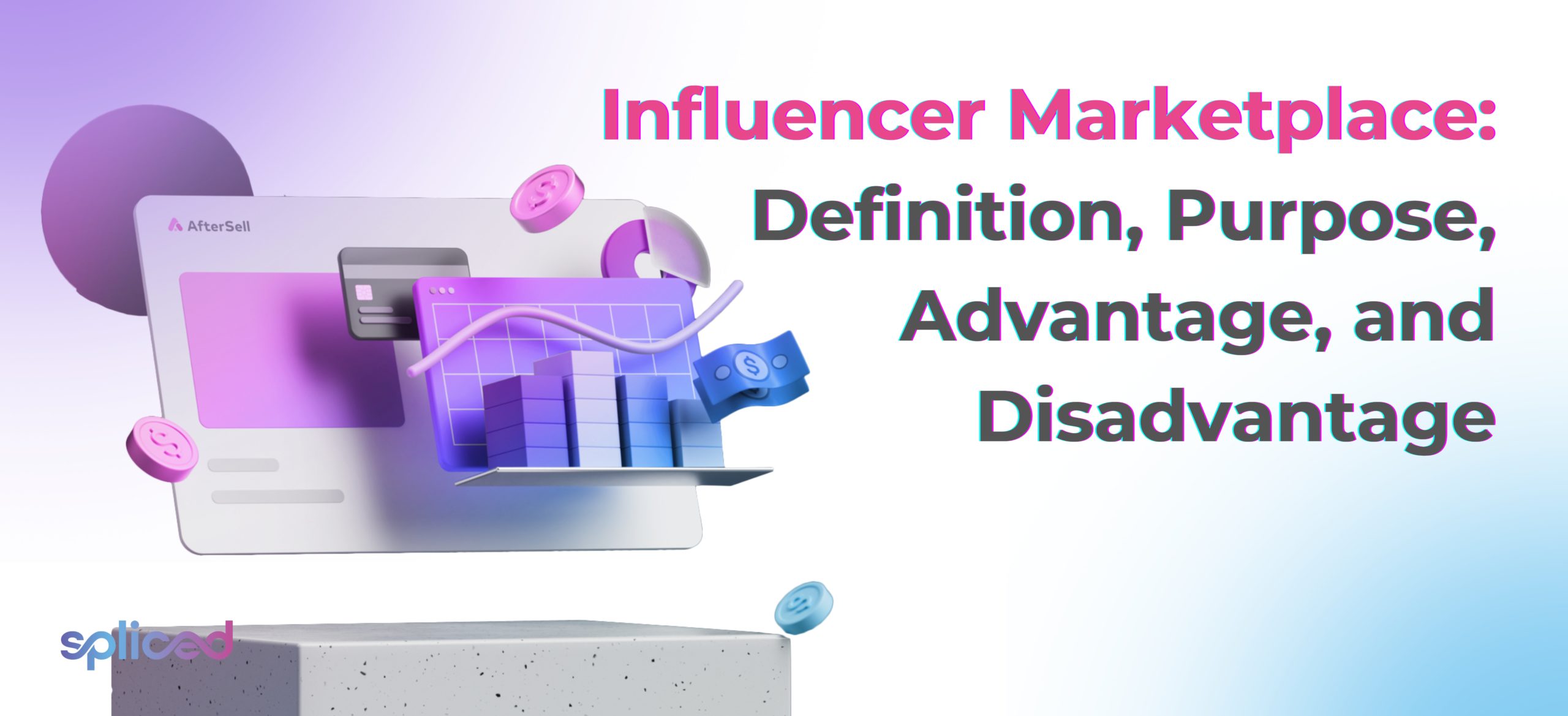Influencer marketplaces are online platforms or networks that link brands and organizations with social media influencers, content creators, and anyone with an enormous online following. Influencer platform acts as go-betweens, granting influencers and brands to unite on marketing campaigns, product promotions, and content development.
The primary objective of influencer marketplaces is to make the influencer marketing procedure more efficient. Influencer marketplaces give a centralized location for brands to locate, vet, and collaborate with influencers who are appropriate to their target viewers and marketing goals. Influencer marketplaces involve tools and services to make campaign administration, negotiating, and performance tracking easier.
Influencer marketplaces provide brands with a quick and easy way to connect with a varied pool of influencers, easing the influencer marketing process. Influencer platforms give transparency through audience statistics, allow for cost-effective collaborations, and enable campaign scalability, making them a necessity for increasing brand reach and connecting with target audiences.
Influencer marketplaces are greatly competitive, making it difficult to gain agreements with prominent influencers. Costs rise, fees apply, and unauthentic content harms a brand’s reputation. Correctly assessing the ROI of influencer marketing remains difficult due to the varied nature of its impact beyond direct sales. Seeking and analyzing “influencer advantage reviews” provide valuable insights for brands looking to make informed decisions in the dynamic field.
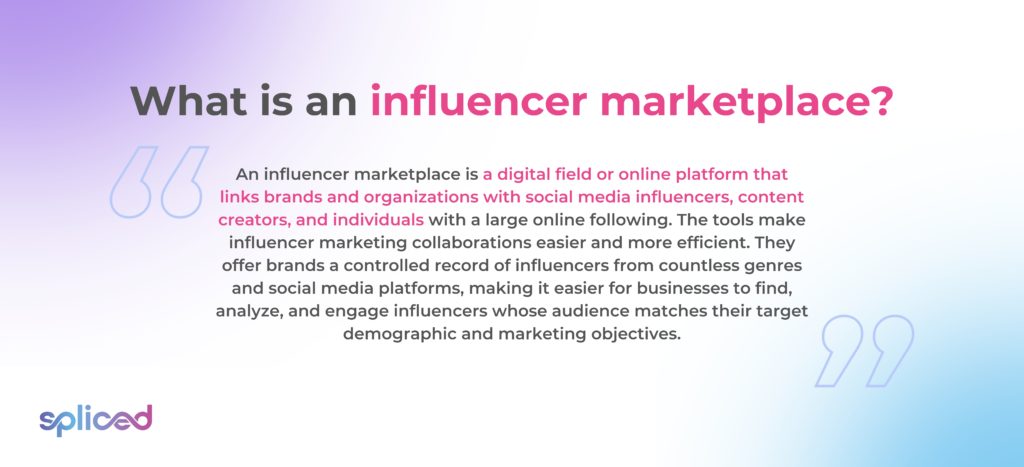
What is an influencer marketplace?
An influencer marketplace is a digital field or online platform that links brands and organizations with social media influencers, content creators, and individuals with a large online following. The tools make influencer marketing collaborations easier and more efficient. They offer brands a controlled record of influencers from countless genres and social media platforms, making it easier for businesses to find, analyze, and engage influencers whose audience matches their target demographic and marketing objectives.
Influencer marketplaces have the transformative power of influencer endorsements and content creation in today’s interconnected digital landscape. The platforms give organizations an extensive suite of tools and services aimed at simplifying the often complex influencer marketing procedure.
Brands receive access to a varied range of influencers through influencer markets, ranging from micro-influencers with specialty audiences to macro-influencers and celebrities with reach. The variety helps organizations select influencers that have follower demographics that closely match their ideal customer profiles, resulting in more successful and focused marketing activities.
The transparency provided by influencer marketplaces is one of their primary benefits. Brands have access to precise analytics and data insights on potential influencers, involving demographic information, engagement rates, and past performance measures. The data-driven approach allows brands to make knowledgeable judgments about influencers, improving the likelihood of successful collaborations.
Influencer marketplaces create risks despite the benefits that they provide. The competitive nature of the platforms leads to a saturation of influencers and companies, making it increasingly difficult to stand out. Expenses greatly depend on the popularity of the influencer, and certain marketplaces impose fees or commission systems, influencing a brand’s budget allotment.
Influencers who are driven purely by financial rewards run the danger of producing unauthentic content. Brands must exercise caution in maintaining the authenticity and credibility of their influencer partnerships to achieve real involvement with the audience.
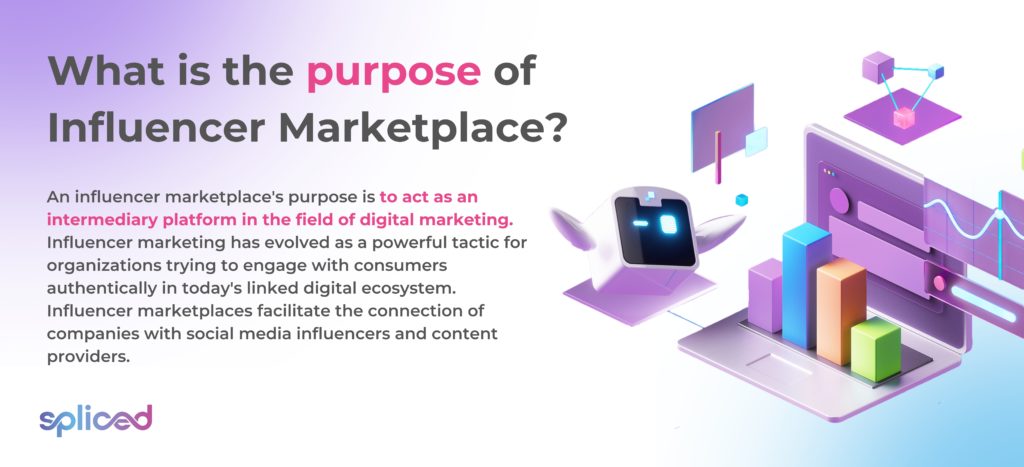
What is the purpose of Influencer Marketplace?
An influencer marketplace’s purpose is to act as an intermediary platform in the field of digital marketing. Influencer marketing has evolved as a powerful tactic for organizations trying to engage with consumers authentically in today’s linked digital ecosystem. Influencer marketplaces facilitate the connection of companies with social media influencers and content providers.
The improvement of efficiency and accessibility for companies is one of the main goals of these marketplaces. Businesses use influencer marketplaces’ curated databases to find potential influencers instead of doing time-consuming manual searches. The systems categorize influencers based on niche, audience size, and social media platform, making it easy to find influencers whose online presence corresponds with the brand’s marketing goals.
Marketplaces for influencers act as a beacon of audience alignment. Brands identify influencers whose follower demographics closely match the demographics of their intended target audience. The alignment is for ensuring that the influencer’s material resonates with and engages the desired consumer audience, boosting the effect of the campaign.
The influencer marketplace provides in-depth data and performance indicators for influencers. Key indicators such as engagement rates, audience demographics, and historical campaign success are evaluated by brands. Organizations make more educated judgments about influencers, increasing the likelihood of successful collaborations.
Influencer markets make it easier to collaborate. The platforms allow direct communication between brands and influencers, streamlining deal-making and campaign administration. Direct engagement guarantees that all sides are on the same page regarding campaign objectives, creative direction, and remuneration terms, resulting in more seamless and effective influencer marketing campaigns.
The varied pool of influencers available in the marketplaces emphasizes their role even more. Influencers range from micro-influencers with specialized specialist followings to macro-influencers that have a wide reach. The variety helps organizations adapt their influencer engagements to certain niches or demographics, ensuring that their campaigns reach the most relevant consumers.
The influencer marketplace makes cost-effective advertising possible. Brands negotiate more attractive and cost-effective relationships by providing a forum for direct negotiations. The influencer marketplace is beneficial for firms with restricted marketing budgets because it allows them to acquire considerable reach without incurring expensive fees.
Influencer marketplace helps to scale campaigns. Brands conduct many influencer campaigns at the same time, each with a different influencer, increasing their reach and targeting different groups of their audience. The scalability boosts the total impact of influencer marketing initiatives, making it a diverse and powerful strategy for organizations looking to utilize the influence of online celebrities to promote their products or services.
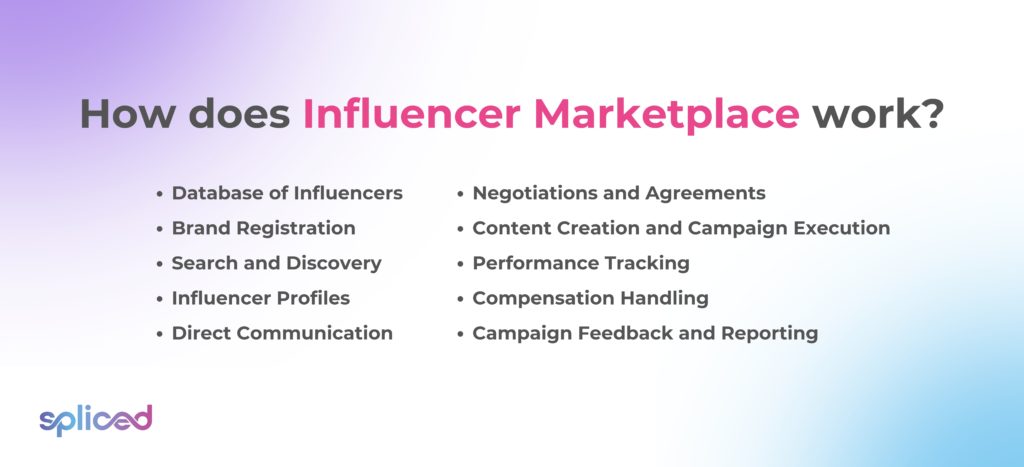
How does Influencer Marketplace work?
The ways how influencer marketplace works are listed below.
- Database of Influencers: Influencer marketplaces keep track of social media influencers, content providers, and people with varied levels of online impact. The databases identify influencers based on factors such as niche, audience size, social media platform, and engagement metrics, giving advertisers a plethora of possibilities.
- Brand Registration: Brands and businesses interested in influencer marketing campaigns register and create profiles on the marketplace.
- Search and Discovery: Brands use search filters and criteria to find influencers that meet their target demographic and campaign objectives. Brands narrow down their search by specifying demographics, interests, geographic location, and more to discover influencers whose followers closely match their ideal customers.
- Influencer Profiles: The marketplace profiles of influencers include comprehensive details about their social media reach, engagement rates, audience demographics, content style, and previous collaborations. Brands have access to influencer profiles to see whether an influencer is a good fit for their campaign based on metrics, content authenticity, and audience attractiveness.
- Direct Communication: Brands establish direct connections with influencers via the marketplace, either through chat or partnership requests. Direct engagement helps businesses to discuss campaign details, negotiate terms, set objectives, and provide creative direction, ensuring that the two sides have a clear understanding.
- Negotiations and Agreements: Influencers and brands bargain over campaign details such as deadlines, payment, and deliverables. Negotiations are part of the influencer marketplace procedure, allowing brands to align their expectations and budget with the influencer’s services and reach a mutually beneficial agreement.
- Content Creation and Campaign Execution: Influencers develop and post content that promotes the brand or product after signing an agreement. Influencers create real and engaging content that incorporates the brand’s messaging and creative direction and is then shared with their individual social media platforms.
- Performance Tracking: Performance tracking and analytics solutions are available in influencer marketplaces. Brands measure the effectiveness and ROI of a campaign by tracking key performance metrics such as reach, engagement, click-through rates, and conversions.
- Compensation Handling: The marketplace is used to coordinate payment and compensation. Payment processing is facilitated by the marketplace, ensuring that influencers receive their paid once campaign deliverables are satisfied.
- Campaign Feedback and Reporting: Brands and influencers discuss marketing results and provide feedback. The feedback process lets the two parties assess the performance of the campaign, identify areas for improvement, and perhaps collaborate on future projects.
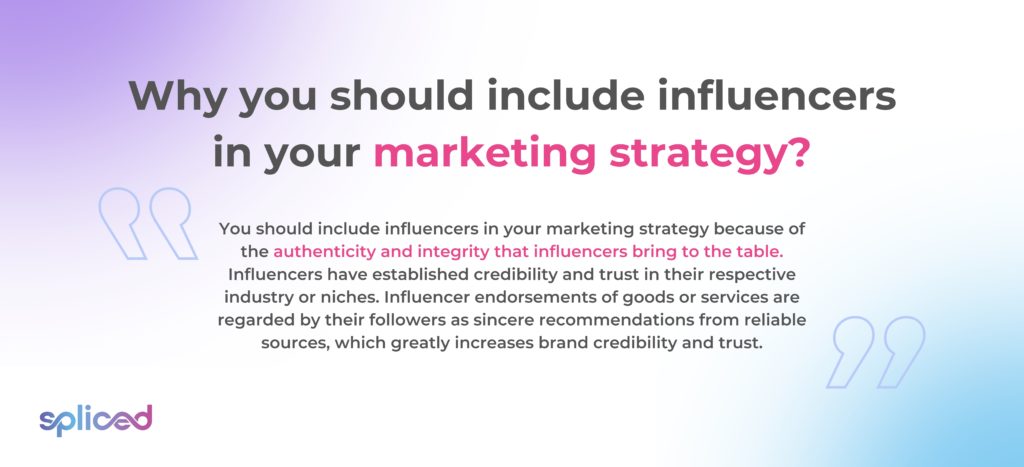
Why you should include influencers in your marketing strategy
You should include influencers in your marketing strategy because of the authenticity and integrity that influencers bring to the table. Influencers have established credibility and trust in their respective industry or niches. Influencer endorsements of goods or services are regarded by their followers as sincere recommendations from reliable sources, which greatly increases brand credibility and trust.
Influencers provide a channel for brands to reach out to certain audiences. Influencers have a large number of followers that share similar interests or demographics. A brand efficiently reaches a bigger and more precisely segmented market by working with influencers who align with the target audience. The tailored strategy has an opportunity to reach prospective clients who are not reachable through standard advertising channels.
Influencers have the unique ability to generate high levels of interaction with their content. Fans of the influencers actively participate in their postings by commenting, liking, and sharing them, establishing a sense of community around the influencer. Influencers’ connection with a brand or product naturally extends to the business, resulting in improved brand recognition and active participation with content.
They create visually beautiful and engaging content that connects with their target audience. A brand’s visual attractiveness is increased when items or services are used in the content, and the narrative is improved too. A brand becomes more engaging and relatable to customers as a result.
Cost-effectiveness is another compelling reason to include influencers in a marketing strategy. Working with influencers is less expensive than launching large-scale ad campaigns. Influencer collaborations provide long-term benefits because their material generates attention and interest over time. The expanded reach and involvement give continued value even after the initial collaboration has finished.
Influencers have the ability to motivate their followers to take immediate actions such as purchases or sign-ups. Many influencers offer discount codes or affiliate links, making it simple for their followers to convert into consumers.
Influencers generate social proof and capitalize on the “Fear of Missing Out” (FOMO) phenomenon. Influencer marketing generates social proof, ensuring potential buyers that others are satisfied with the goods. People do not want to miss out on a popular or endorsed product or activity, therefore FOMO increases purchases and engagement.
Influencer marketing yields quantifiable results. KPIs such as engagement rates, click-through rates, website traffic, and conversion rates are all capable of being tracked. The data-driven strategy provides a comprehensive evaluation of the performance of influencer initiatives to make informed judgments about future marketing strategies.

What are the types of influencer marketplaces?
The types of influencer marketplaces are listed below.
- General Influencer Marketplaces: Platforms that host a varied range of influencers from many sectors and businesses are known as general influencer marketplaces. Brands use particular criteria to find influencers and collaborate with them on campaigns spanning several niches. General Influencer marketplaces offer a diverse range of influencers, making them ideal for firms with a variety of marketing requirements. They provide influencer selection flexibility, allowing firms to explore multiple sectors and demographics.
- Niche-Specific Influencer Marketplaces: Platforms that focus solely on influencers in a given expertise or industry are known as topic-specific influencer marketplaces. Brands looking for influencers with deep experience in a certain industry find them on Niche-Specific Influencer Marketplaces. Niche marketplaces provide tailored influencer pools, making it easier for marketers to locate influencers with extensive knowledge and authority in their target industry. These platforms are useful for initiatives that require specialized knowledge.
- Local or Regional Influencer Marketplaces: Local or regional influencer markets target influencers in a specific geographic area. The platforms are perfect for brands that want to interact with a specific regional audience or those that have localized marketing initiatives. Influencers with considerable reach and impact in specific areas are found in local or regional marketplaces. They help firms create a local consumer base or advertise location-specific products and services.
- Micro-Influencer Marketplaces: Micro-influencer marketplaces specialize in linking companies with micro-influencers, who have small but engaged and loyal followings. Micro-influencer marketplace platforms are perfect for brands looking for genuine and unique connections. Influencers with a smaller but more dedicated and influential audience are prioritized by micro-influencer marketplaces. Micro-influencers are more honest and approachable to their followers, making them valuable for particular projects.
- Celebrity and Mega-Influencer Agencies: Celebrity and mega-influencer agencies represent well-known individuals with large online followings, such as celebrities, athletes, and public figures. Brands work with such firms to acquire endorsements from well-known influencers. These firms specialize in cultivating relationships with high-profile influencers and facilitating brand collaborations. Brands tend to collaborate with celebrities and mega-influencers to reach a large and diversified audience.
- B2B Influencer Platforms: B2B influencer platforms are designed expressly for the demands of business-to-business (B2B) influencer marketing. B2B influencer platforms connect marketers with B2B industry influencers who help promote products and services in that environment. They provide access to influencers capable of communicating sophisticated and industry-specific themes to a professional audience.
- Diverse and Inclusive Influencer Platforms: Diverse and Inclusive Influencer platforms focus on promoting diversity and inclusivity in influencer marketing. Diverse and Inclusive Influencer Platforms connect brands with underrepresented influencers to promote diversity and inclusivity in marketing initiatives. Diverse and inclusive influencer platforms encourage representation and give influencers from various ethnic, cultural, gender, and social backgrounds a platform. These platforms are used by brands trying to interact with varied consumer demographics to ensure inclusivity in their advertising.
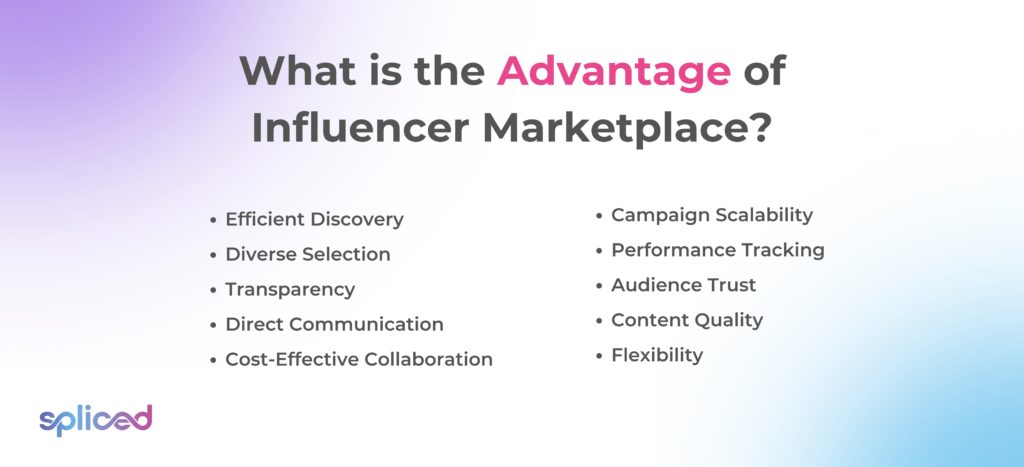
What is the Advantage of Influencer Marketplace?
The advantages of influencer marketing places are listed below.
- Efficient Discovery: Influencer marketplaces make it easy for marketers to find and interact with influencers that match their target demographic and campaign objectives. Compared to a manual influencer search, such effectiveness saves time and effort.
- Diverse Selection: The markets provide a broad pool of influencers, ranging from micro-influencers with small followings to celebrities with large followings. Brands have the option to select influencers that most closely match the ones of their desired customers.
- Transparency: Influencer marketplaces offer in-depth statistics and data insights on influencers. Brands gain access to data on engagement rates, audience demographics, and previous campaign results, allowing them to make more knowledgeable decisions.
- Direct Communication: Brands engage directly with influencers via the marketplace, easing negotiations, campaign planning, and the development of clear expectations.
- Cost-Effective Collaboration: Many influencer markets allow marketers to negotiate terms and budgets with influencers directly. Comparing direct communication to more conventional advertising techniques results in more cost-effective collaborations.
- Campaign Scalability: Brands have the ability to run many campaigns with different influencers at the same time, effectively expanding their reach and targeting different demographics.
- Performance Tracking: The platforms incorporate performance tracking and measurement tools, allowing marketers to track key performance parameters and assess the ROI of influencer marketing initiatives.
- Audience Trust: Influencers have earned the trust of their followers, and their endorsements are seen as genuine suggestions. The trust helps to improve a company’s reputation and credibility.
- Content Quality: Influencers are knowledgeable content makers. Working with them provides high-quality, engaging content that resonates with their target audience and is consistent with the brand’s messaging.
- Flexibility: Influencers are chosen by brands based on their specific campaign needs, such as enhancing brand awareness, driving website traffic, or increasing sales. Influencer marketplaces provide the ability to identify the best fit for any campaign.
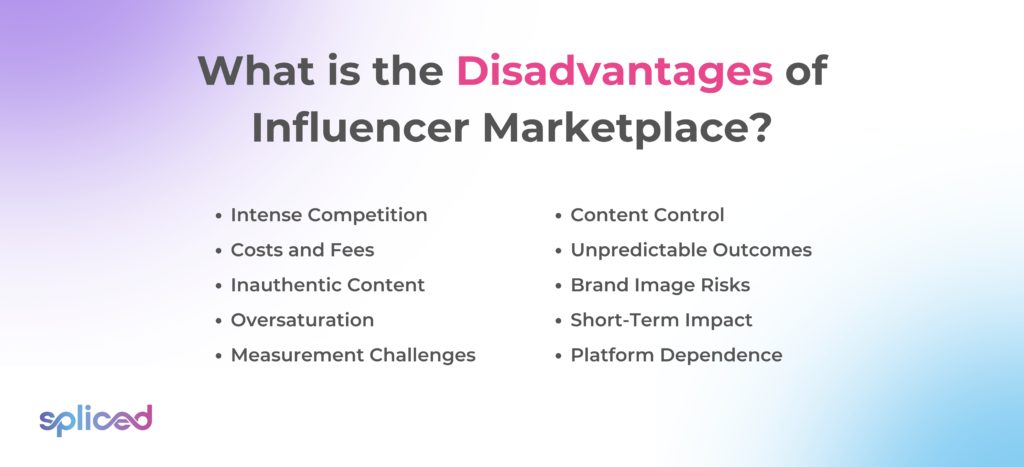
What are the disadvantages of Influencer Marketplace?
The disadvantages of the Influencer Marketplace are listed below.
- Intense Competition: Influencer marketplaces are extremely competitive, with numerous marketers fighting for the attention of well-known influencers. The competition makes securing collaborations with top-tier influencers difficult.
- Costs and Fees: Working with well-known influencers, especially macro-influencers, and celebrities, are costly. Certain influencer marketplaces impose fees or take part in the collaboration expenditure, which affects the total cost.
- Inauthentic Content: Influencers who put financial incentives ahead of real alignment with a business run the danger of producing content that is not authentic. Inauthentic Content results in disengaged viewers and potential brand damage.
- Oversaturation: The market becomes oversaturated as more businesses and influencers join influencer markets. The oversaturation lessens the novelty and impact of influencer efforts, making it more difficult for brands to stand out.
- Measurement Challenges: Measuring the return on investment (ROI) of influencer marketing efforts is difficult. Accurately estimating the impact is difficult due to the presence of numerous intangible components, such as brand recognition and reputation.
- Content Control: Brands have minimal control over the material created by influencers. Influencers have creative flexibility, and even while partnership agreements specify rules, it leads to content that does not exactly match what brands want to see.
- Unpredictable Outcomes: The results of influencer marketing are uncertain. There is no certainty of how the public is going to react to influencer endorsements, even with careful planning, making precise forecasting difficult.
- Brand Image Risks: Associating with the wrong influencer or being involved in a public issue with the influencer jeopardizes a brand’s image and reputation. Brands must carefully vet influencers to reduce the risks.
- Short-Term Impact: Influencer marketing strategies provide instant effects, such as increases in website traffic or sales. Long-term brand growth includes continual influencer relationships or other marketing techniques.
- Platform Dependence: Social media networks are mostly used for influencer marketing. Changes in algorithms, platform restrictions, or the popularity of specific platforms all affect the reach and success of influencer efforts.
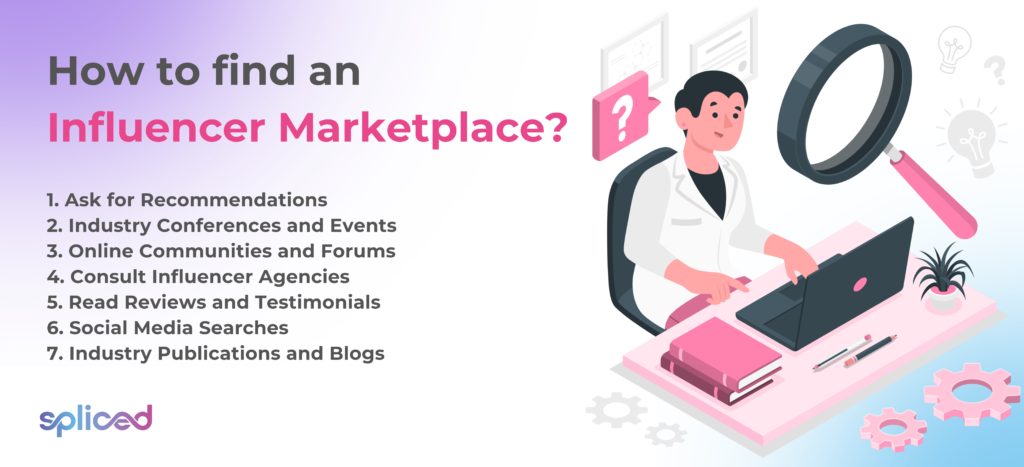
How to find an Influencer Marketplace?
The ways to find an influencer marketplace are listed below.
- Ask for Recommendations: Contact peers, coworkers, or industry contacts with influencer marketing experience.
- Industry Conferences and Events: Accompany marketing, social media, or influencer marketing industry conferences, seminars, and events. The gatherings contain conversations regarding influencer marketing platforms, and attendees have the opportunity to network with individuals who are willing to provide advice.
- Online Communities and Forums: Participate in marketing or influencer marketing-related online communities, forums, and social media groups. Inquire about suggestions or insights from members of the community who have used influencer marketplaces.
- Consult Influencer Agencies: Consider contacting influencer marketing or consultancy organizations. Consult Influencer Agencies have knowledge in the sector and they recommend appropriate influencer marketplaces based on the goals of publicizing.
- Read Reviews and Testimonials: Seek feedback and testimonials from brands that utilize influencer marketplaces.
- Social Media Searches: Use social media networks such as Twitter, LinkedIn, and Instagram to search for influencers and influencer marketing platforms. Influencers make mention of their platform usage. Searching in social media is one of the best ways how to find influencers.
- Industry Publications and Blogs: Investigate marketing and influencer marketing-related periodicals, blogs, and websites. The publications include articles or advice about influencer marketplaces.
What is the best Influencer Marketplace platform?
Spliced is the best influencer marketplace platform for a variety of compelling reasons, making it a popular choice among companies and marketers. Spliced enormous database of influencers, which covers a wide range of niches and social media platforms, is one of its most notable characteristics. The range helps marketers locate influencers whose followers closely match their target population, allowing for more successful and focused influencer marketing efforts. It is one of the reasons why it is the best influencer marketing platform.
The platform’s extensive search and filtering features are one of the key advantages. The tools allow brands to tailor their influencer search based on specific parameters such as demographics, region, engagement rates, and more. The targeted approach raises the chances of locating the ideal influencers who honestly connect with the brand’s audience.
Spliced offers a major emphasis on data-driven insights. Spliced offers complete analytics and performance metrics for influencers, giving brands vital information about an influencer’s reach, engagement, audience demographics, and historical campaign performance. The data assists marketers in making informed decisions when selecting influencers for their campaigns and determining campaign objectives.
Spliced provides in-platform communication and collaboration solutions for campaign management, which streamline the negotiation process. Communication and collaboration guarantee that companies and influencers are on the same page when it comes to campaign expectations, creative direction, and remuneration conditions. Brands use content approval capabilities to guarantee content uniformity.
Spliced features complete tracking capabilities for measuring campaign success, allowing marketers to monitor important performance data in real time. The data-driven approach helps brands to make quick campaign adjustments, optimizing reach, engagement, and conversion rates.
The dedication to audience authenticity is another noteworthy component of Spliced. The platform uses AI-powered algorithms to determine the legitimacy of an influencer’s followers, assisting brands in avoiding concerns caused by phony or inactive followers. The focus on actual connection adds trust and legitimacy to influencer partnerships.
Spliced global reach makes it appropriate for brands doing both domestic and foreign campaigns. The platform provides bespoke influencer marketing solutions to the specific demands of each company and campaign, increasing flexibility and adaptability.
Consumers get confidence from case studies and success stories that demonstrate the successful results attained by brands employing Spliced’s services. The real-world examples show how the platform is used to increase brand exposure, engagement, and conversions through influencer marketing.
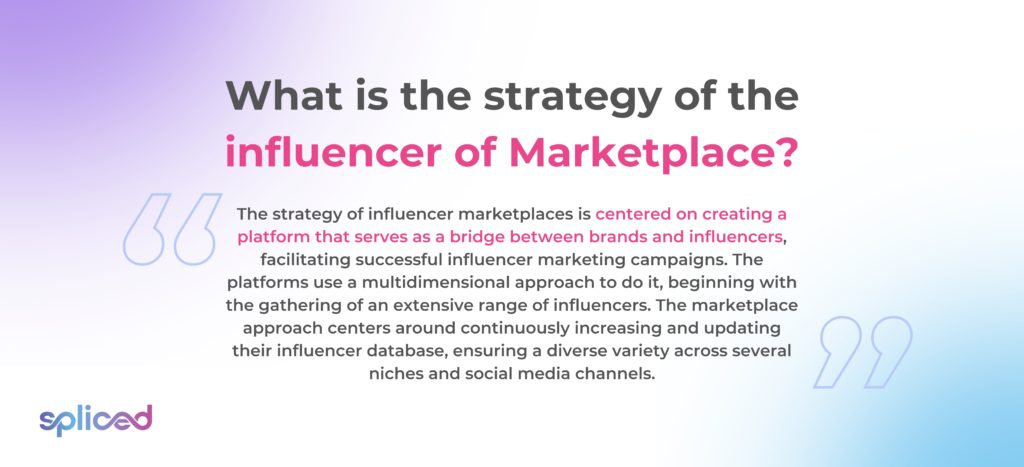
What is the strategy of the influencer of Marketplace?
The strategy of influencer marketplaces is centered on creating a platform that serves as a bridge between brands and influencers, facilitating successful influencer marketing campaigns. The platforms use a multidimensional approach to do it, beginning with the gathering of an extensive range of influencers. The marketplace approach centers around continuously increasing and updating their influencer database, ensuring a diverse variety across several niches and social media channels. The variety permits marketers to locate influencers whose follower demographics closely match their objective population, which is a key component of useful influencer marketing.
Brands utilize the tools to refine their influencer search by applying filters and parameters. The characteristics involve demographics, engagement rates, geography, and niche expertise. Influencer marketplaces improve the accuracy of influencer discovery by allowing marketers to discover influencers who perfectly suit their demands, boosting the odds of successful collaborations.
Influencer marketplaces provide thorough information on influencer performance, including reach, engagement, audience demographics, and previous campaign performance. Brands select influencers wisely and establish advertising objectives by using their insights. The data-driven influencer marketing strategy increases the efficacy of influencer marketing activities.
Influencer marketplaces provide a set of tools to help with campaign management. Brands engage with influencers directly through the site, coordinate campaign elements, and even review material before it goes public. The technique ensures that the sides have the same expectations for the campaign, creative direction, and remuneration conditions. The solutions give brands control over content consistency, which is required for brand image and message.
The platforms contain tools that allow brands to trace performance data in real-time. The real-time data helps brands measure the performance of their influencer marketing efforts as they develop, allowing for quick adjustments and optimization of results.
Many influencer markets use AI-powered algorithms to determine the authenticity of an influencer’s followers. The verification procedure assists brands in avoiding concerns associated with false or inactive followers, thus protecting the integrity and effectiveness of influencer partnerships.
Influencer marketplaces strive for global reach, making them appropriate for marketers running local and international campaigns. The technique involves bringing in influencers from different locations and ensuring that the platform appeals to a varied user base. The influencer marketplace model relies heavily on customization. The platforms give customizable influencer marketing solutions that are suited to the specific requirements of each company and campaign. The method increases flexibility and adaptability, allowing influencer marketing tactics to appeal to various industry sectors and campaign objectives.
Educational resources and standards are components of influencer marketplace strategy. Many platforms offer information to assist brands and influencers in effectively navigating the influencer marketing landscape. The strategy attempts to encourage best practices, build effective collaborations, and guarantee that businesses and influencers understand the complexities of influencer marketing.
Influencer marketplaces feature case studies and success stories from firms that have seen excellent outcomes from their platform. The method instills trust in users by showing the platform’s effectiveness in increasing brand recognition, involvement, and conversions. It demonstrates the tangible value that brands gain from influencer marketing efforts executed through the marketplace.
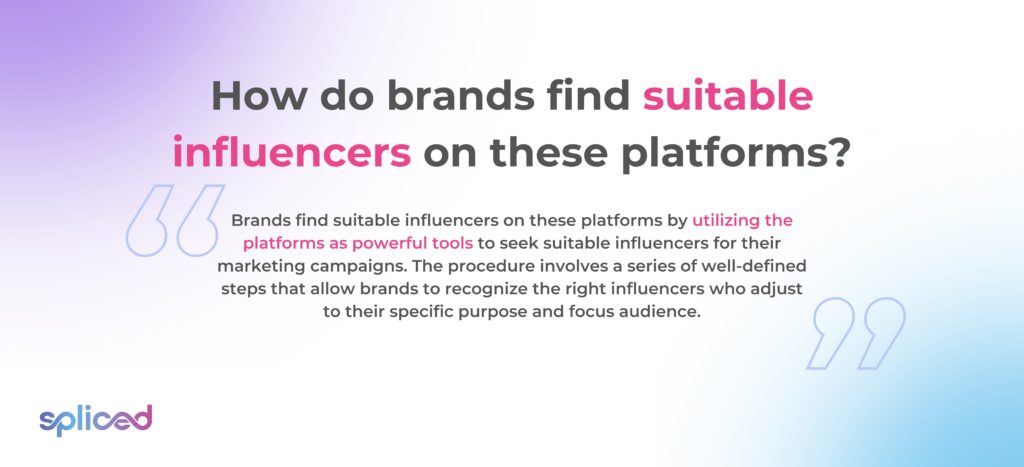
How do brands find suitable influencers on these platforms?
Brands find suitable influencers on these platforms by utilizing the platforms as powerful tools to seek suitable influencers for their marketing campaigns. The procedure involves a series of well-defined steps that allow brands to recognize the right influencers who adjust to their specific purpose and focus audience.
The main feature of the platforms is the availability of sophisticated search filters, which let brands define their conditions. The search filters contain demographic factors such as age, gender, and location. Brands reduce the pool of prospective influencers to those whose followers closely mirror their ideal customer profiles by employing filters.
Brands examine their marketing objectives when seeking influencers. Brands search for influencers who work and reputation fit their goals, whether they want to increase product sales, increase website traffic, or raise brand exposure. They examine an influencer’s previous cooperation to establish their efficacy in accomplishing similar objectives.
Brands investigate the content of influencers to guarantee that it seamlessly incorporates their products or services. Maintaining authenticity and resonating with the influencer’s audience requires a natural relationship between the influencer’s content and the brand’s products.
Brands look at engagement metrics to establish an influencer’s level of audience participation. Metrics such as likes, comments, and shares offer insightful information about an influencer’s capacity for sincere engagement with their followers. Brands assess the influencer’s followers’ authenticity at the same time to make sure they are not artificially inflated with false or acquired followers.
Influencer marketplace platforms include information about an influencer’s past success, such as reach, engagement rates, and conversion rates. Brands apply the data to create educated conclusions regarding an influencer’s suitability for a campaign.
Brands disclose directly with influencers via the site to discuss campaign data, expectations, and remuneration terms. The engagement helps marketers to assess the influencer’s professionalism and willingness to work efficiently with them.
Certain platforms have content approval capabilities that allow brands to examine and approve influencer-generated material before it is published. The phase ensures that the material adheres to the brand’s guidelines and messaging, ensuring consistency throughout the campaign.
Brands consider whether an influencer’s fees are in line with their campaign budget. Brands negotiate terms with the influencer directly through the platform to create mutually advantageous arrangements.
Brands looking for long-term relationships with influencers assess an influencer for long-term collaborations and partnerships. The strategy guarantees that influencer marketing efforts are consistent and continuous.
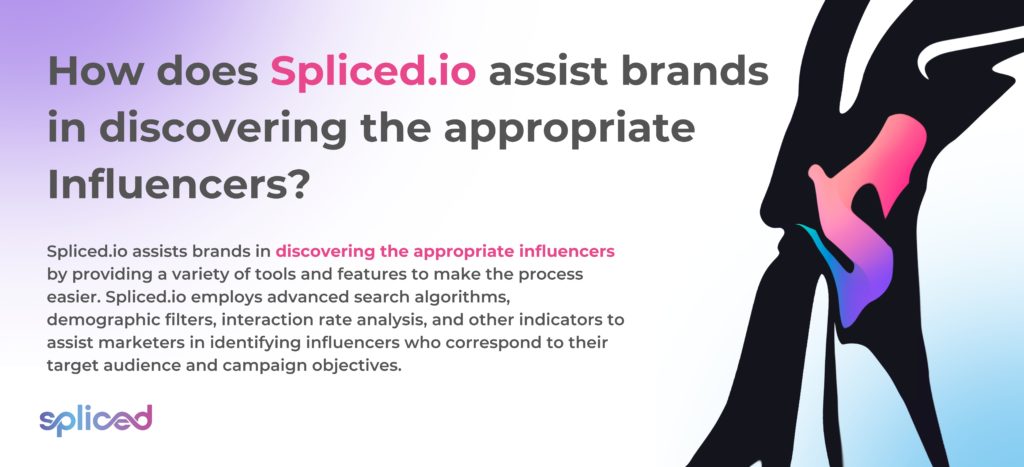
How does Spliced assist brands in discovering the appropriate Influencers?
Spliced assists brands in discovering the appropriate influencers by providing a variety of tools and features to make the process easier. Spliced.io employs advanced search algorithms, demographic filters, interaction rate analysis, and other indicators to assist marketers in identifying influencers who correspond to their target audience and campaign objectives. Spliced.io provides a database of influencers from various niches, allowing marketers to research and connect with influencers who are a good fit for their needs.
Data-driven information on an influencer’s historical performance, audience demographics, and the efficiency of previous collaborations are provided by Spliced.io. The data allows marketers to make informed judgments about influencers for their marketing.
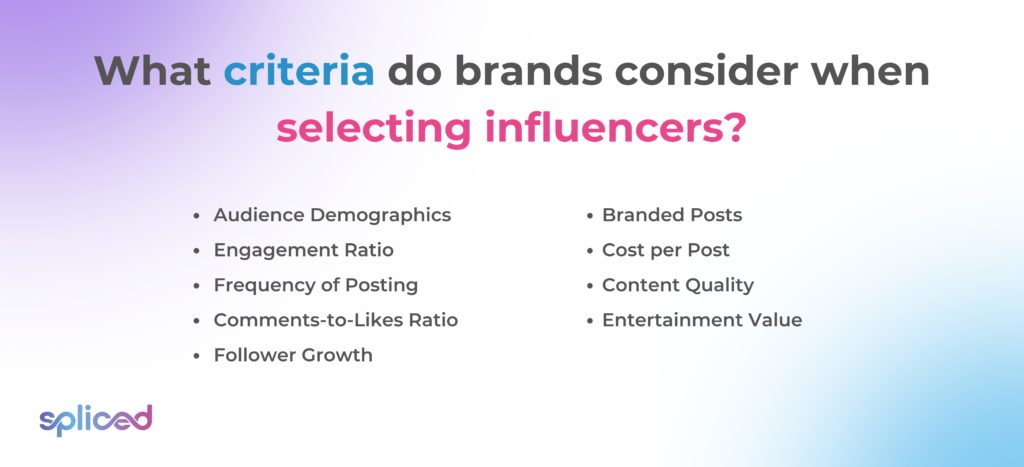
What criteria do brands consider when selecting influencers?
The criteria brands consider when selecting influencers are listed below.
- Audience Demographics: Brands take into account the demographics of an influencer’s followers, such as age, gender, geography, and interests. The matching of the demographics with the brand’s target audience is a must for effective influencer marketing.
- Engagement Ratio: Brands look at an influencer’s engagement rate, which evaluates how much interaction their material receives in comparison to the number of followers they have. A greater engagement ratio shows that the audience is more engaged and receptive.
- Frequency of Posting: Brands look at how an influencer posts material. Consistency in posting helps to retain audience engagement and keeps the influencer at the front of their followers’ minds.
- Comments-to-Likes Ratio: The ratio represents the proportion of likes and comments on an influencer’s posts. Brands seek influencers that have a healthy balance of the two, as comments indicate active involvement and debates about the material.
- Follower Growth: Brands consider the rate at which an influencer’s follower count is growing. Steady and organic follower growth is preferred over sudden spikes, which indicates the use of unauthentic growth tactics.
- Branded Posts: Companies investigate an influencer’s previous collaborations with other companies. They look to see if the influencer has previously collaborated with competitors or produced content that contradicts the brand’s image or messaging.
- Cost per Post: Brands assess the influencer’s fee and whether it fits inside their campaign budget. The cost of each post varies according to factors such as the influencer’s reach and niche expertise.
- Content Quality: Brands assess the quality of an influencer’s content, considering factors such as creativity, aesthetics, storytelling, and production value. High-quality content enhances a brand’s image and message.
- Entertainment Value: Brands consider whether an influencer’s content is entertaining, engaging, and resonates with their target audience. Content that entertains and captivates viewers creates a positive brand impression.
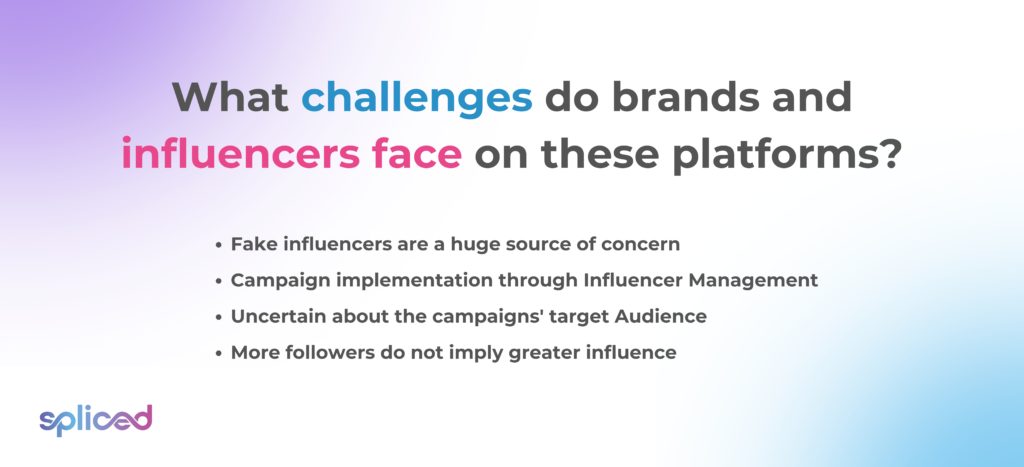
What challenges do brands and influencers face on these platforms?
The challenges brands and influencers face on these platforms are listed below.
- Fake influencers are a huge source of concern.: Fake influencers with artificially exaggerated follower count or engagement metrics pose a big difficulty. Brands must distinguish between genuine influencers and influencers that use deceitful approaches.
- Campaign implementation through Influencer Management: Managing influencer relationships and ensuring that influencers follow campaign standards and schedules is difficult. Coordination of content creation and approvals requires good campaign management.
- Uncertain about the campaigns’ target Audience: Brands and influencers have difficulty effectively identifying and targeting the intended audience of a campaign. Ineffective campaigns result from misalignment with the target population.
- More followers do not imply greater influence: Influence does not come with a large following. Brands and influencers must grasp that genuine influence is founded on engagement, trust, and the capacity to motivate followers to take action.
- Inconsistency in Influencer Performance and ROI: Measuring the return on investment (ROI) of influencer marketing efforts is difficult. Brands fail to precisely assess their influence and lack clear performance criteria.
- Finding relevant influencers who are going to support the campaigns: Identifying influencers whose content and values connect with the brand and campaign message is time-consuming.
- Engagement in sponsored posts has decreased.: Sponsored posts have lower engagement rates than organic content. The goal is to find a happy medium between promotional content and audience engagement.
- Long-Term Collaboration with Influencers: Long-term collaborations with influencers are difficult to establish and maintain. Influencers’ objectives and commitments shift, and maintaining a consistent collaboration requires continual effort.
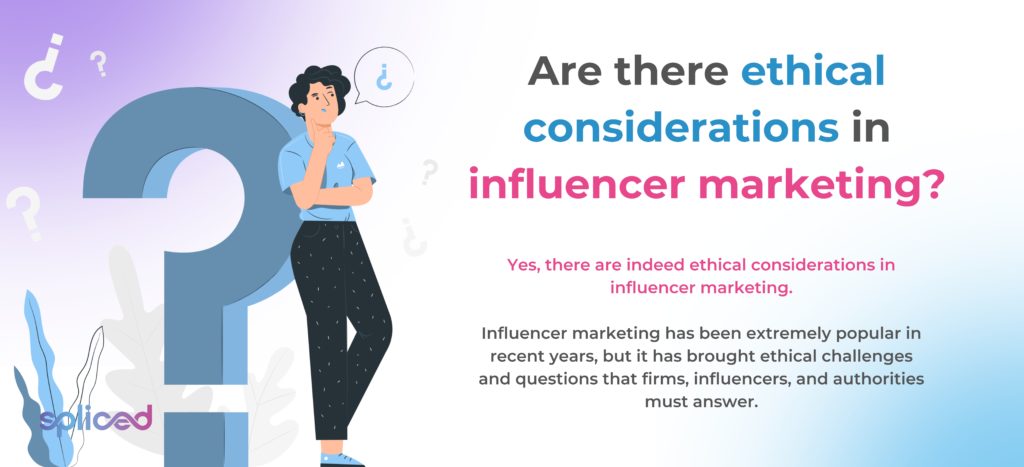
Are there ethical considerations in influencer marketing?
Yes, there are indeed ethical considerations in influencer marketing. Influencer marketing has been extremely popular in recent years, but it has brought ethical challenges and questions that firms, influencers, and authorities must answer.
Transparency and disclosure are ethical foundations in influencer marketing. Influencers must explicitly identify their partnerships and specify when their content is sponsored or part of a paid effort. Transparency is not just a moral imperative, but it is required by advertising restrictions. Failure to disclose leads to customer misinformation undermines trust, and regulatory penalties. Ethical influencers embrace openness to maintain their audience’s authenticity and reputation.
The foundation of ethical influencer marketing is authenticity and honesty. Brands and influencers must stress authenticity in their collaborations. Promoting products or services just for financial gain, rather than a genuine belief in their worth, undermines an influencer’s credibility and hurts a brand’s reputation. Ethical influencers carefully identify collaborations that connect with their values and resonate with their audience, ensuring that their endorsements are genuine and not motivated primarily by monetary considerations.
Influencers have a duty to their fans, especially those who have sizable fan bases. Influencers must be cautious about the items and messages they promote. Promoting dangerous or misleading content has a negative impact on their followers, especially susceptible ones. It includes promoting health and wellness products responsibly and avoiding pseudoscientific or deceptive claims. Ethical influencers put the well-being of their audience over short-term financial rewards.
Data protection and permission are two major ethical problems in influencer marketing. Brands and influencers are required to abide by laws and regulations governing data privacy. Obtaining appropriate consent and being honest about data usage meet basic ethical standards for protecting consumer privacy and rights.
Influencer marketing is governed by regulations in several countries, such as the FTC standards in the United States. Compliance with such constraints, which include full disclosure of sponsored material and respect to advertising standards, is required for ethical influencer marketing.
Brands must compensate influencers fairly for their efforts. Unfair pricing or underpayment leads to influencers supporting companies for financial gain, jeopardizing authenticity. Ethical pay techniques ensure that influencers are driven more by a true belief in the things they promote than by financial incentives.
Ethical considerations extend to long-term relationships between brands and influencers. Transparency, equity, and moral principles must be upheld by all sides throughout all contracts and collaborations. Ethical influencer marketing builds long-term collaborations based on mutual benefit and trust.
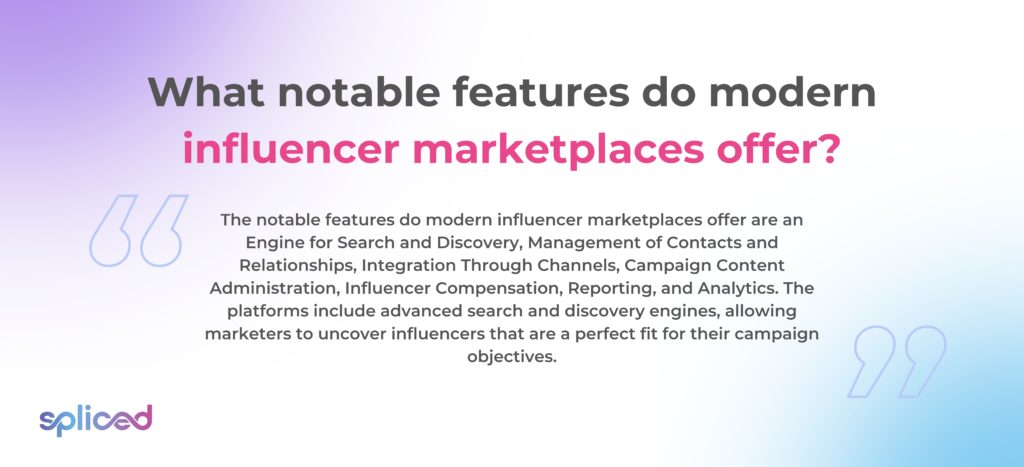
What notable features do modern influencer marketplaces offer?
The notable features do modern influencer marketplaces offer are an Engine for Search and Discovery, Management of Contacts and Relationships, Integration Through Channels, Campaign Content Administration, Influencer Compensation, Reporting, and Analytics. The platforms include advanced search and discovery engines, allowing marketers to uncover influencers that are a perfect fit for their campaign objectives. Influencers are filtered by demographics, niche knowledge, engagement rates, and location, enabling a precise match between influencers and target audiences.
Tools for managing contacts and relationships let brands and influencers communicate more effectively. Brands use the platform to start and continue dialogues with influencers, enabling clear and successful collaboration. The function is especially useful for ensuring that the two parties understand campaign expectations, creative direction, and remuneration terms.
Integration with numerous social media platforms makes cross-channel influencer campaigns easier. Brands easily share content across several platforms while tracking performance indicators in a single dashboard. The integration improves campaign administration and reporting, making it easier to track the effectiveness of influencer marketing initiatives throughout the digital landscape.
Campaign Content Administration systems allow marketers to monitor and regulate influencer-generated content. Brands evaluate and approve material before it goes live, ensuring that it complies with brand requirements and messaging. The feature helps ensure uniformity and brand integrity throughout the campaign.
Influencer compensation methods are built into these platforms. Brands and influencers negotiate compensation conditions in the marketplace in an open and transparent manner, fostering fairness and clarity in financial arrangements. The feature assists both parties in determining compensation that correctly represents the scope and objectives of the campaign.
Reporting and Analytics insights into influencer performance and campaign efficacy are provided through analytics and reporting technologies. Key indicators including reach, engagement rates, audience demographics, and conversion statistics are tracked by brands. The analytics provide data-driven decision-making, allowing brands to enhance influencer marketing strategies and measure campaign ROI.
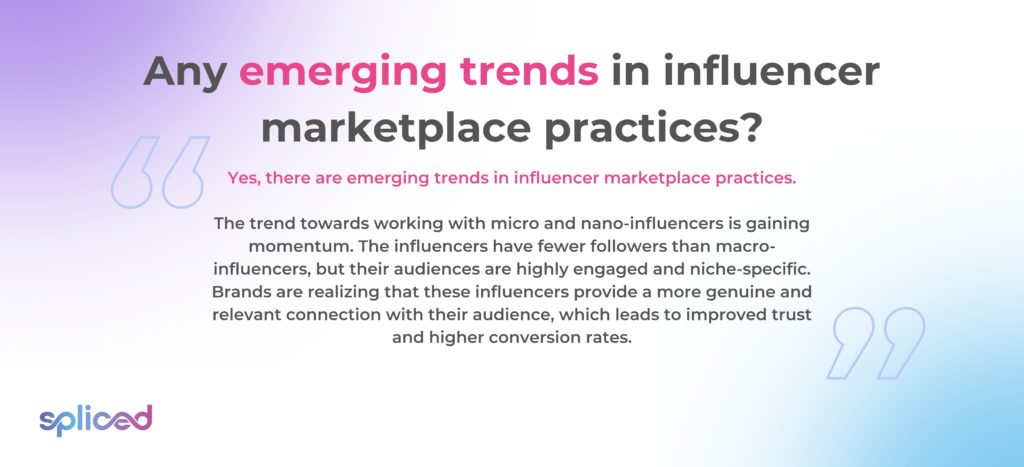
Any emerging trends in influencer marketplace practices?
Yes, there are emerging trends in influencer marketplace practices. The trend towards working with micro and nano-influencers is gaining momentum. The influencers have fewer followers than macro-influencers, but their audiences are highly engaged and niche-specific. Brands are realizing that these influencers provide a more genuine and relevant connection with their audience, which leads to improved trust and higher conversion rates. Collaborating with micro and nano-influencers is cost-effective for brands, making it a desirable trend.
Long-term collaborations between companies and influencers are becoming more common. Brands are looking to develop ongoing collaborations with influencers rather than one-time efforts. The strategy is founded on the assumption that long-term relationships result in more genuine endorsements and deeper ties with the influencer’s audience. It allows brands to develop a unified brand narrative over time.
Brands and influencers focus more on producing authentic content that connects with their target audience. Brands and influencers encourage transparency in sponsored content by openly revealing partnerships and paid advertising. Maintaining trust with their audience is critical, and the trend emphasizes the significance of authentic storytelling in influencer marketing.
Diversity and inclusivity are gaining traction. Influencers from various origins and groups are actively sought by brands to engage with a diverse variety of consumer demographics. The tendency shows a greater awareness of the significance of representation and inclusion in marketing initiatives.
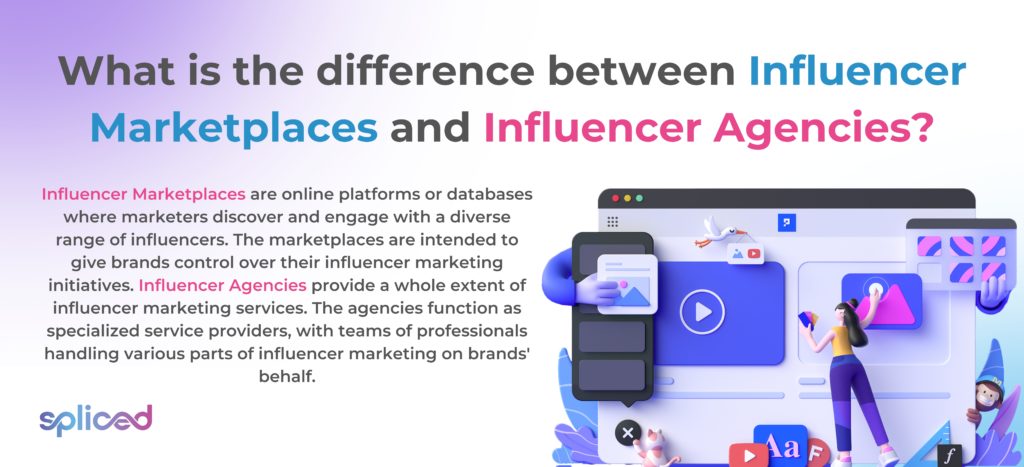
What is the difference between Influencer Marketplaces and Influencer Agencies?
Influencer Marketplaces are online platforms or databases where marketers discover and engage with a diverse range of influencers. The marketplaces are intended to give brands control over their influencer marketing initiatives. Brands search for influencers based on specific parameters such as demographics, niche, engagement rates, and location. They begin relationships, bargain terms, and handle campaign implementation independently after they have identified potential influencers. The approach gives brands more control and flexibility when it comes to influencer selection and campaign management. Influencer markets are an excellent resource for marketers wishing to engage with influencers directly and personalize their campaigns to their personal tastes.
Influencer Agencies provide a whole extent of influencer marketing services. The agencies function as specialized service providers, with teams of professionals handling various parts of influencer marketing on brands’ behalf. Influencer agencies handle the selection, negotiation, and management of influencers. They use their business knowledge and contacts with influencers to streamline the influencer marketing procedure. Agencies help firms develop influencer marketing plans, assure the quality of content, obtain permissions, and monitor the achievement of campaigns in addition to assisting with influencer recruiting. The all-inclusive approach gives brands a hands-off solution, allowing them to delegate the complexities of influencer marketing to professionals. It limits their direct control over influencer interactions and content development while the technique minimizes marketers’ workload.
Influencer marketplaces serve as platforms for discovering, and connecting influencers, and letting communication between companies and influencers. Influencer marketplaces do not provide full-service campaign management but do give tools for influencer search, communication, and campaign tracking. Influencer agencies provide entire influencer marketing services, aiding clients in campaign strategy, identifying relevant influencers, negotiating agreements, guaranteeing content quality, and measuring campaign success. They provide detailed data and analytics, providing a complete picture of campaign performance.
The price and pricing structure differ. Brands that use influencer marketplaces often have further transparency in influencer pricing because they negotiate straight with influencers and allocate money accordingly. Influencer agencies charge a fee for their services, which varies based on the scale of the campaign and the agency’s competence. The fee covers the agency’s management services but adds to the overall campaign cost.
